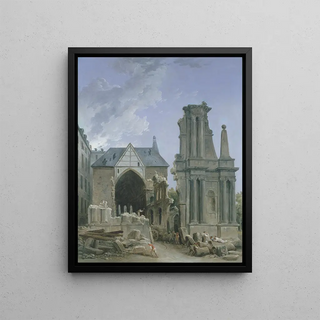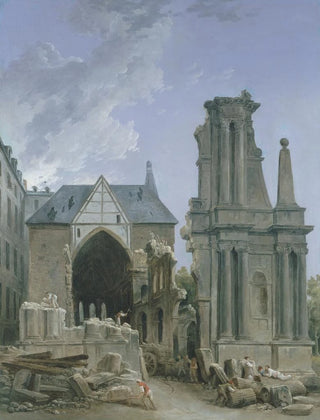Art print | The Church of the Feuillants being demolished - Hubert Robert


View from behind

Frame (optional)
Reproduction of L'Église des Feuillants en démolition - Hubert Robert – Captivating Introduction
The artwork "L'Église des Feuillants en démolition" by Hubert Robert immerses us in a universe where history and nature intertwine, revealing the fleeting beauty of human structures in the face of the inexorable passage of time. This painting, dating from the 18th century, offers a poignant vision of desolation and melancholy, while celebrating the architectural grandeur of a declining edifice. Through this depiction, Robert does not merely document a moment of destruction; he invites the viewer to reflect on the fragility of cultural heritage and on how time shapes our environment. Thus, this piece becomes a mirror of our own existence, where each element of the scene resonates with emotional depth.
Style and uniqueness of the work
Hubert Robert's style is characterized by an exceptional mastery of light and shadow, creating atmospheres that are both dramatic and poetic. In "L'Église des Feuillants en démolition," there is a skillful use of colors, where earthy tones blend with touches of golden light, emphasizing the contrast between the ruin and the enduring beauty of the surrounding nature. The debris, collapsed stones, and trees rising in the background testify to a dialogue between man and his environment, where nature seems to reclaim its rights over the remnants of the edifice. This work also illustrates the artist's taste for the picturesque, a trend prevalent in the 18th century, while marking a break with the academic conventions of his time. Hubert Robert thus manages to capture a scene of great emotional intensity, where destruction becomes an art form in itself, revealing the hidden beauty in decline.
The artist and his influence
Hubert Robert, often nicknamed "the painter of ruins," established himself as an emblematic figure of 18th-century French art. Trained at the Royal Academy of Painting and Sculpture, he was influenced by the great masters of the Renaissance, while developing a style that is uniquely his own. His passion for architecture and urban landscapes

Matte finish

View from behind

Frame (optional)
Reproduction of L'Église des Feuillants en démolition - Hubert Robert – Captivating Introduction
The artwork "L'Église des Feuillants en démolition" by Hubert Robert immerses us in a universe where history and nature intertwine, revealing the fleeting beauty of human structures in the face of the inexorable passage of time. This painting, dating from the 18th century, offers a poignant vision of desolation and melancholy, while celebrating the architectural grandeur of a declining edifice. Through this depiction, Robert does not merely document a moment of destruction; he invites the viewer to reflect on the fragility of cultural heritage and on how time shapes our environment. Thus, this piece becomes a mirror of our own existence, where each element of the scene resonates with emotional depth.
Style and uniqueness of the work
Hubert Robert's style is characterized by an exceptional mastery of light and shadow, creating atmospheres that are both dramatic and poetic. In "L'Église des Feuillants en démolition," there is a skillful use of colors, where earthy tones blend with touches of golden light, emphasizing the contrast between the ruin and the enduring beauty of the surrounding nature. The debris, collapsed stones, and trees rising in the background testify to a dialogue between man and his environment, where nature seems to reclaim its rights over the remnants of the edifice. This work also illustrates the artist's taste for the picturesque, a trend prevalent in the 18th century, while marking a break with the academic conventions of his time. Hubert Robert thus manages to capture a scene of great emotional intensity, where destruction becomes an art form in itself, revealing the hidden beauty in decline.
The artist and his influence
Hubert Robert, often nicknamed "the painter of ruins," established himself as an emblematic figure of 18th-century French art. Trained at the Royal Academy of Painting and Sculpture, he was influenced by the great masters of the Renaissance, while developing a style that is uniquely his own. His passion for architecture and urban landscapes






